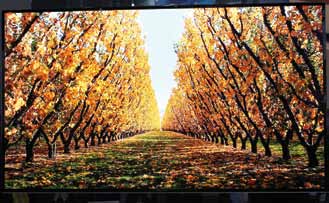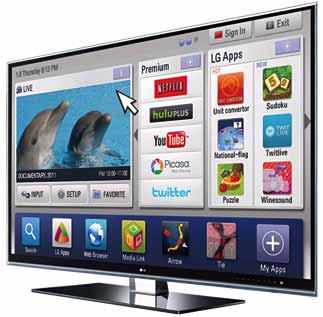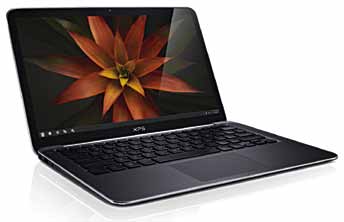Ever-larger TV screens with pin-sharp images in brilliant colour, 3D viewing with and without glasses, lightweight yet fast ultrabooks, IT and telecom devices with network capabilities, for the home and on the move–IFA 2012 trade fair (to be held in Berlin, Germany, from 31st August to 5th September) presents trends from every part of the consumer electronics industry. Take a look
1. Ultra high-resolution TVs with brilliant colours
High-definition TV sets have become a part of almost every household and this year’s hot topic is 4k. Resolution is now up to 4096×2160 (4k) pixels—equivalent to more than 8 megapixels—so viewers are bound to be amazed by pin-sharp images. With four times the resolution of full HD now available, this technology is ideal for beamers and large screens.

4k panels also make it possible to view stereoscopic films. Compared to conventional full HD screens, these have twice the number of lines. This makes it possible to build 3D TVs that produce images in full HD even when viewed with passive glasses. Even if there are no 4k TV broadcasts on the horizon, this new technology can impressively contribute to further improving image quality, particularly that of large-scale screens.
Another emerging trend in flat-screen technology is the use of organic light-emitting diodes (OLEDs). OLED displays require no additional light source and, compared to conventional LCDs, produce high-contrast images. While LCD cells only work as colour filters, OLED pixels emit light in colour and consequently very impressive images.
OLED displays are very thin, making them ideal for devices with very slim designs. To date they have found their way into mobile phones, smartphones and tablet PCs. Small OLED TVs have been on the market for some time now and later this year the first large (140cm) OLED sets will go on sale.
LG and Samsung have already demonstrated their 140cm (55-inch) OLED TV. While Samsung was reported to launch its OLED-TV at IFA 2012 in Berlin this September, LG was expected to launch its OLED-TV in May itself. TPV Technology, which has taken over the Philips TV brand, will also showcase an OLED TV at IFA 2012.
2. 3D with and without glasses
3D technology continues to develop. Glasses for enjoying 3D viewing are now being made with lighter and more stylish frames which can be comfortably worn with normal spectacles.

According to reports, Sony is planning to bring passive 3D TVs to the market. It might even exhibit the first passive 3D displays at IFA 2012. Passive 3D doesn’t use any electronics in the glasses. So the glasses are much simpler, lighter and affordable than active 3D glasses.
Also, TV sets are now hitting the market which require no glasses for 3D viewing. Toshiba’s ZL2 TV set, for instance, allows 3D viewing without glasses. The TV uses the cutting-edge 4k resolution.
3. Ease of operation
For many users, operating a smart TV still remains a complex affair. For this reason, the industry is urgently working to solve the problem with hardware and software that can simplify the process.
New operating concepts are among this year’s dominant home entertainment trends. Many TVs can already be remotely operated via a tablet or smartphone, eliminating the need for a remote control. Now the first consumer electronics devices, in particular TVs, that are capable of reacting to voice and gesture commands are coming onto the market.
One example is Samsung’s smart TV. With this TV, a simple gesture is all it takes to access your favourite movies, sports, apps and other smart content. Forget the remote. Instead, use your hands to control TV functions by swiping to navigate and grabbing to select.
4. Smart TVs
Conventional broadcasts are not the only thing that smart TVs can receive. These can also access Internet content and services. Owners can start apps on-screen, play games with partners in the cloud, take out films from mediatheques, or keep in touch with friends through e-mails, Skype, Twitter or Facebook.

The technology which device manufacturers have developed to get Web content varies, although the different methods they use all look very similar. In addition to apps, some smart TVs also feature browsers that can surf the Internet similar to a PC. Special apps for smartphones and tablets connected to the living room TV via a wireless home network feature virtual keyboards that make navigating on-screen content especially easy.
Products vary depending on the manufacturer. Some companies have already set up developer communities for TV apps in order to concentrate the creative potential within the IT scene and to rapidly increase the diversity available in the market.
By 2011 some six million Internet TVs had already been sold. According to market researchers, in 2012 every second set sold in Germany will be a smart TV. The current market volume stands at 5.5 million sets.
The gradual convergence of television and the Internet over the last three years will become an even more dominant market trend, both in 2012 and beyond. It is not just a technology trend but one that also defines a new business model approach within the consumer electronics industry. In future, the degree to which companies can combine device features with content services and the degree to which hardware manufacturers and content providers can cooperate across individual business sectors will significantly determine the level of their success.
5. Second screens—a second display on one’s lap
Smart TVs capable of accessing both the Web for entertainment as well as hard drives and computers via a home network in order to automatically search for photos, music and images present a challenge in terms of ergonomics. Digitally navigating one’s way with only a few cursor keys requires a great deal of patience.
Tablets and smartphones provide the answer. In future, these will evolve into universal navigators of media services and functions. The way in which a large living room TV set interacts with a miniature wireless display on the viewer’s lap will be among the most exciting innovations.
One of the many operating scenarios is as follows: A digital camera forms part of a W-LAN home network, which both a TV set and tablet are able to automatically recognise. Touching the camera icon on the tablet shows an overview of the user’s last photos. Swiping the tablet display in the direction of the TV set starts up a slideshow of the photos on the large-screen TV.
6. Ultrabooks—between tablets and notebooks
Last year tablets were the big hit. In 2012, ultrabooks are setting a new trend. These are extremely thin, have extended battery life, boot up in seconds and sport handsome looks. Some models even let the user decide whether to operate this mobile device as a notebook or tablet. Weighing only 1 to 2 kilograms, ultrabooks fully match the performance of a conventional notebook.

Ultrabooks have been launched by companies like Wipro, Samsung, Acer, Lenovo, Toshiba, Dell and Hewlett Packard.
7. Home networking—an unbroken trend
Consumer electronics devices that are part of a home network and communicate with household appliances, heating and lighting systems are yet another innovation that in the years to come will represent an increasingly important trend.
Incorporating individual components into networks opens up huge possibilities. Photos, music and videos are no longer stored on shelves and in albums. Nowadays these are archived digitally on PCs, notebooks and network hard drives and, via the home network, can be retrieved by virtually any digital device—be it a smartphone, networked TV set or a tablet. Standards such as UPnP and DLNA make accessing media in a home network easy. The network components recognise each other automatically and are thus able to exchange digital content.
The trend towards networked media access has also profoundly changed the world of hi-fi. Nowadays it is possible to set up a home network with fixed or wireless connections that incorporates innumerable music components and surround systems and retrieves media from a single location. In such cases, smartphones function as easy-to-operate remote controls which, using special apps, can navigate music archives.
Radios also have a firm place in the networked household. Audio components in a home network can usually access the Internet where they can find a huge trove of local and international digital radio stations. Thus the Web has become one of the most important disseminators of digital radio content.
Users can also access their home network while on the move—for example, in order to retrieve stored information or to program a video recording.
Communication between consumer electronics components and household appliances opens up a wealth of possibilities for future applications. Washing machines can be monitored via a smartphone or tablet while their owners are on the move. The lighting or blinds in the house can be activated even when on holiday. When shopping, users can be alerted to low food stocks in the fridge.
Incorporating more and more components into a digitally networked world creates an even greater potential for new applications. As a result, hardly anything can stand in the way of the imagination of developers, engineers and scientists.






